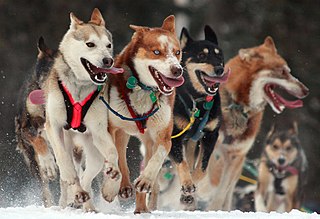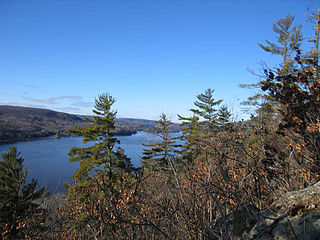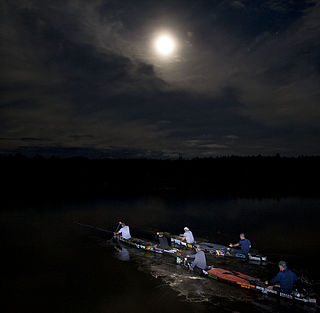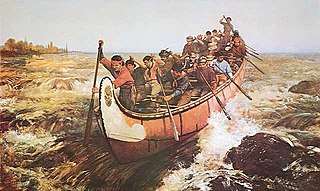
A coureur des bois or coureur de bois was an independent entrepreneurial French Canadian trader who travelled in New France and the interior of North America, usually to trade with First Nations peoples by exchanging various European items for furs. Some learned the trades and practices of the indigenous peoples.

Mushing is a sport or transport method powered by dogs. It includes carting, pulka, dog scootering, sled dog racing, skijoring, freighting, and weight pulling. More specifically, it implies the use of one or more dogs to pull a sled, most commonly a specialized type of dog sled on snow, or a rig on dry land.

The Quebec Winter Carnival, commonly known in both English and French as Carnaval, is a pre-Lenten festival held in Quebec City. After being held intermittently since 1894, the Carnaval de Québec has been celebrated annually since 1955. That year, Bonhomme Carnaval, the mascot of the festival, made his first appearance. Up to one million people attended the Carnaval de Québec in 2006 making it, at the time, the largest winter festival in the world. It is, however, the largest winter festival in the Western Hemisphere.

The Gatineau River is a river in western Quebec, Canada, which rises in lakes north of the Baskatong Reservoir and flows south to join the Ottawa River at the city of Gatineau, Quebec. The river is 386 kilometres (240 mi) long and drains an area of 23,700 square kilometres (9,200 sq mi).

The Au Sable River Canoe Marathon, presented by Consumers Energy, is an annual 120 mi (193 km) canoe race in Michigan from Grayling to Oscoda. Nicknamed and known simply as "The Marathon," it first ran in 1947, and is perhaps the oldest marathon canoe race in the United States, and is the longest, non-stop, canoe-only race in North America. The race has been billed as "The World's Toughest Spectator Race" as many of the spectators follow the racers overnight down the full 120 miles (190 km) to the finish.
Jean-Claude Labrecque, was a director and cinematographer who learned the basics of filmmaking at the National Film Board of Canada.

Serge Corbin is a Canadian professional marathon canoe racer and a native of St. Boniface, Quebec.

The Société de transport de Lévis also known as STLevis (Lévis Transit Corporation) is a public transportation agency created in 1980, operating mainly in Lévis on the south shore of the Saint Lawrence River, being the counterpart of the Réseau de transport de la Capitale (RTC) on the north side. STLevis offers connections between Lévis and Quebec City; RTC buses currently do not have any services to the south shore.

A rabaska or Maître canoe was originally a large canoe made of tree bark, used by the Algonquin people.

This article covers the water based Canadian canoe routes used by early explorers of Canada with special emphasis on the fur trade.

Voyageurs were 18th and 19th century French Canadians who transported furs by canoe at the peak of the North American fur trade. The emblematic meaning of the term applies to places and times where that transportation was over long distances. The voyageurs' strength and endurance was regarded as legendary. They were celebrated in folklore and music. For reasons of promised celebrity status and wealth, this position was coveted.

The Triple Crown of Canoe Racing is a canoe marathon series consisting of:

The Ha! Ha! River is a watercourse in Saguenay–Lac-Saint-Jean, Quebec, Canada.
The Chemin des Canots River is a tributary of the Malbaie River, flowing into the unorganized territory of Lac-Pikauba in the Charlevoix Regional County Municipality, in the Capitale-Nationale administrative region, in the province of Quebec, in Canada. The Chemin des Canots River crosses the eastern part of the Laurentides Wildlife Reserve; it flows into a river bend on the southwestern bank of the Malbaie River facing the zec des Martres.
The Rivière aux Canots Est is a tributary of the Rivière aux Canots, flowing in the unorganized territories of Lac-Achouakan and Lac-Moncouche, the Lac-Saint-Jean-Est Regional County Municipality, in the administrative region of Saguenay–Lac-Saint-Jean, in the province of Quebec, in Canada. The course of the Rivière aux Canots Est crosses the Laurentides Wildlife Reserve.
The lac aux Écorces is a freshwater body crossed by the Rivière aux Écorces, in the unorganized territory of Lac-Jacques-Cartier, in the La Côte-de-Beaupré Regional County Municipality, in the administrative region of Capitale-Nationale, in the province from Quebec, to Canada. Lac aux Écorces is part of the Laurentides Wildlife Reserve.
The rivière aux Canots is a tributary of the east bank of the Métabetchouane River, flowing in the unorganized territory of Belle-Rivière, in the Lac-Saint-Jean-Est Regional County Municipality, in the administrative region of Saguenay–Lac-Saint-Jean, in the province of Quebec, in Canada. The upper part of this river crosses the Laurentides Wildlife Reserve.
The bras des Canots is a tributary of the Valin River, flowing in the unorganized territory of Mont-Valin, in the Le Fjord-du-Saguenay Regional County Municipality, in the administrative region of Saguenay-Lac-Saint-Jean, in Quebec, in Canada. The course of the Bras des Canots flows mainly in the Monts-Valin National Park.
Lac Martin-Valin is a freshwater body of the watershed of bras des Canots, located on the north shore of the St. Lawrence River, in the unorganized territory of Mont-Valin, in the Le Fjord-du-Saguenay Regional County Municipality, in the administrative region of the Saguenay-Lac-Saint-Jean, in the province of Quebec, Canada.












